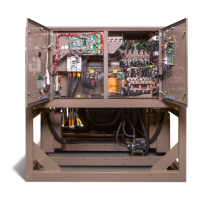JOHNSON CONTROLS
162
SECTION 9 - MAINTENANCE
Form 201.47-ICOM1
Issue date: 17/11/2022
Checking the system for leaks
Leak testing
The refrigerant side of the system is carefully pressure
tested and evacuated at the factory.
After the system has been charged, the system must
be carefully leak tested with a refrigerant- compatible
leak detector to ensure that all joints are tight. The ac-
ceptable limit for a 100% pure R-134a/R-513A system
is 0.1 oz/year at DWP.
If any leaks are indicated, they must be repaired imme-
diately. At times, leaks can be stopped by ensuring that
face seal nuts and flange bolts are correctly torqued.
However, for any major repair, the refrigerant charge
must be removed, and the system leak checked using
reliable methods like a pressure test.
See Removing the refrigerant charge for service on
page 171 for reference.
Leak testing during operation
After the system has been charged, the system must be
carefully leak tested with a compatible leak detector to
ensure that all joints are tight. The acceptable limit for
a 100% pure R-134a/R-513A system is 0.1 oz/year at
DWP.
If any leaks are indicated, they must be repaired imme-
diately. Usually, leaks can be stopped by tightening the
O-ring face seal (ORFS) fitting, flare nuts, or flange
bolts. However, for any major repair, the refrigerant
charge must be removed.
Vapor connection locations
To be able to correctly evacuate, leak test, and charge
the YVAA system, all the vapor connections must be
aligned correctly to conduct a correct system service.
See Figure 63 on page 162 for these locations.
Ensure that all valves in the system, in-
cluding the condenser and the economizer
EEVs manual valves and ball valves are
100% open, when any procedures such
as leak checks, evacuation, or refrigerant
handling service are being performed on
the chiller system as a whole.
Use these service valves for all vapor and charging
connection processes. This includes evacuation, vacu-
um gauge connection, vapor, and liquid charging.
Figure 63 - Service connections

